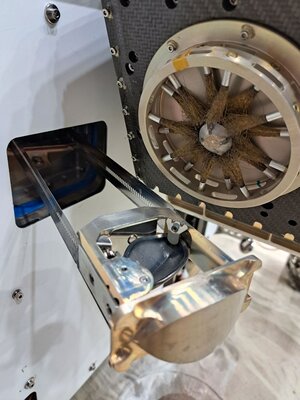Accept all cookies Accept only essential cookies See our Cookie Notice

About ESA
The European Space Agency (ESA) is Europe’s gateway to space. Its mission is to shape the development of Europe’s space capability and ensure that investment in space continues to deliver benefits to the citizens of Europe and the world.
Highlights
ESA - United space in Europe
This is ESA ESA facts Member States & Cooperating States Funding Director General Top management For Member State Delegations European vision European Space Policy ESA & EU Space Councils Responsibility & Sustainability Annual Report Calendar of meetings Corporate newsEstablishments & sites
ESA Headquarters ESA ESTEC ESA ESOC ESA ESRIN ESA EAC ESA ESAC Europe's Spaceport ESA ESEC ESA ECSAT Brussels Office Washington OfficeWorking with ESA
Business with ESA ESA Commercialisation Gateway Law at ESA Careers Cyber resilience at ESA IT at ESA Newsroom Partnerships Merchandising Licence Education Open Space Innovation Platform Integrity and Reporting Administrative Tribunal Health and SafetyMore about ESA
History ESA Historical Archives Exhibitions Publications Art & Culture ESA Merchandise Kids Diversity ESA Brand Centre ESA ChampionsLatest
Space in Member States
Find out more about space activities in our 23 Member States, and understand how ESA works together with their national agencies, institutions and organisations.
Science & Exploration
Exploring our Solar System and unlocking the secrets of the Universe
Go to topicAstronauts
Missions
Juice Euclid Webb Solar Orbiter BepiColombo Gaia ExoMars Cheops Exoplanet missions More missionsActivities
International Space Station Orion service module Gateway Concordia Caves & Pangaea BenefitsLatest
Space Safety
Protecting life and infrastructure on Earth and in orbit
Go to topicAsteroids
Asteroids and Planetary Defence Asteroid danger explained Flyeye telescope: asteroid detection Hera mission: asteroid deflection Near-Earth Object Coordination CentreSpace junk
About space debris Space debris by the numbers Space Environment Report In space refuelling, refurbishing and removingSafety from space
Clean Space ecodesign Zero Debris Technologies Space for Earth Supporting Sustainable DevelopmentLatest
Applications
Using space to benefit citizens and meet future challenges on Earth
Go to topicObserving the Earth
Observing the Earth Future EO Copernicus Meteorology Space for our climate Satellite missionsCommercialisation
ESA Commercialisation Gateway Open Space Innovation Platform Business Incubation ESA Space SolutionsLatest
Enabling & Support
Making space accessible and developing the technologies for the future
Go to topicBuilding missions
Space Engineering and Technology Test centre Laboratories Concurrent Design Facility Preparing for the future Shaping the Future Discovery and Preparation Advanced Concepts TeamSpace transportation
Space Transportation Ariane Vega Space Rider Future space transportation Boost! Europe's Spaceport Launches from Europe's Spaceport from 2012Latest

Martian ovens
Thank you for liking
You have already liked this page, you can only like it once!
There are few things better than the smell of freshly baked bread from the oven, this is because molecules in the bread disperse in the heat to reach your nose. In a similar way, the ExoMars rover Rosalind Franklin will ‘bake’ and ‘sniff’ martian samples in miniature ovens, imaged above, as part of its investigation of the extra-terrestrial world.
Set to land on Mars in 2021, Rosalind Franklin will scout areas of interest and drill up to 2 m below the surface and report back its findings to scientists on Earth.
Nothing short of a miniature laboratory on wheels, the dirt that Rosalind Franklin collects will pass through different steps in an intricate process allowing for many types of analysis to get the best possible overview of the composition of Mars so far.
The Mars Organic Molecule Analyser, “MOMA”, will heat samples to unlock the organic molecules from the Martian dust and transform them into the gas phase. The gas produced will then flow past a receptor that ‘sniffs’ the molecules to learn more about the sample, thanks to its gas chromatograph.
Baked to up to 800°C in the pyrolysis ovens, the investigations are a one-shot affair. The samples are arranged around the circumference of a rotating carrousel, so that each tube can be placed under the sample funnel and positioned in the tapping station where the samples are ‘cooked’ and ‘sniffed’.
The thumb-sized gold-coloured tubes are hollow to hold the samples. At the tapping station a sphere pushes down on the oven rim to ensure an airtight seal during heating. The double golden pins are the connectors that send electricity running into the ovens.
The silver-coloured rod is a calibration target for a second component of MOMA dubbed ‘LDMS’ that uses laser heating (desorption) and mass spectrometry to analyse the samples. The rod is used to create a standard value for the laser on the Red Planet to ensure that LDMS is working correctly. Together MOMA’s gas chromatographer and LDMS will target biomarkers to answer questions related to the potential origin, evolution and distribution of life on Mars.
Choosing when and where to take a Martian sample, and choosing which instrument to analyse the sample with, will be a discussion of interplanetary proportions for scientists, but that discussion will need to reach conclusions quickly: the ExoMars rover has 31 tubes to fill and analyse and is designed to work for 218 “sols” or Martian days.
MOMA is built by a scientific consortium led by the Max-Planck-Institut für Sonnensystemforschung in Göttingen, Germany, with the gas chromatograph built by LISA (Laboratoire Interuniversitaire des Systèmes Atmosphériques) in Paris, France, and the LDMS by NASA’s Goddard Spaceflight Center in Greenbelt, USA. These miniature ovens are part of the rover on-board laboratory “ultra clean zone” that was designed by Thales Alenia Space in Italy, and mounted on a carrousel developed by OHB in Munich, Germany.
ESA has demonstrated expertise in studying Mars from orbit, now we are looking to secure a safe landing, to rove across the surface and to drill underground to search for evidence of life. Our orbiters are already in place to provide data relay services for surface missions. The next logical step is to bring samples back to Earth, to provide access to Mars for scientists globally, and to better prepare for future human exploration of the Red Planet. This week we’re highlighting ESA’s contribution to Mars exploration as we ramp up to the launch of our second ExoMars mission, and look beyond to completing a Mars Sample Return mission. Join the conversation online with the hashtag #ExploreFarther
-
CREDIT
Thales Alenia Space -
LICENCE
ESA Standard Licence

Moving the ExoMars Analytical Laboratory Drawer

ExoMars Analytical Laboratory Drawer

ExoMars rover comes out of the ‘oven’

ExoMars drill ready for sample transfer















 Germany
Germany
 Austria
Austria
 Belgium
Belgium
 Denmark
Denmark
 Spain
Spain
 Estonia
Estonia
 Finland
Finland
 France
France
 Greece
Greece
 Hungary
Hungary
 Ireland
Ireland
 Italy
Italy
 Luxembourg
Luxembourg
 Norway
Norway
 The Netherlands
The Netherlands
 Poland
Poland
 Portugal
Portugal
 Czechia
Czechia
 Romania
Romania
 United Kingdom
United Kingdom
 Slovenia
Slovenia
 Sweden
Sweden
 Switzerland
Switzerland

























